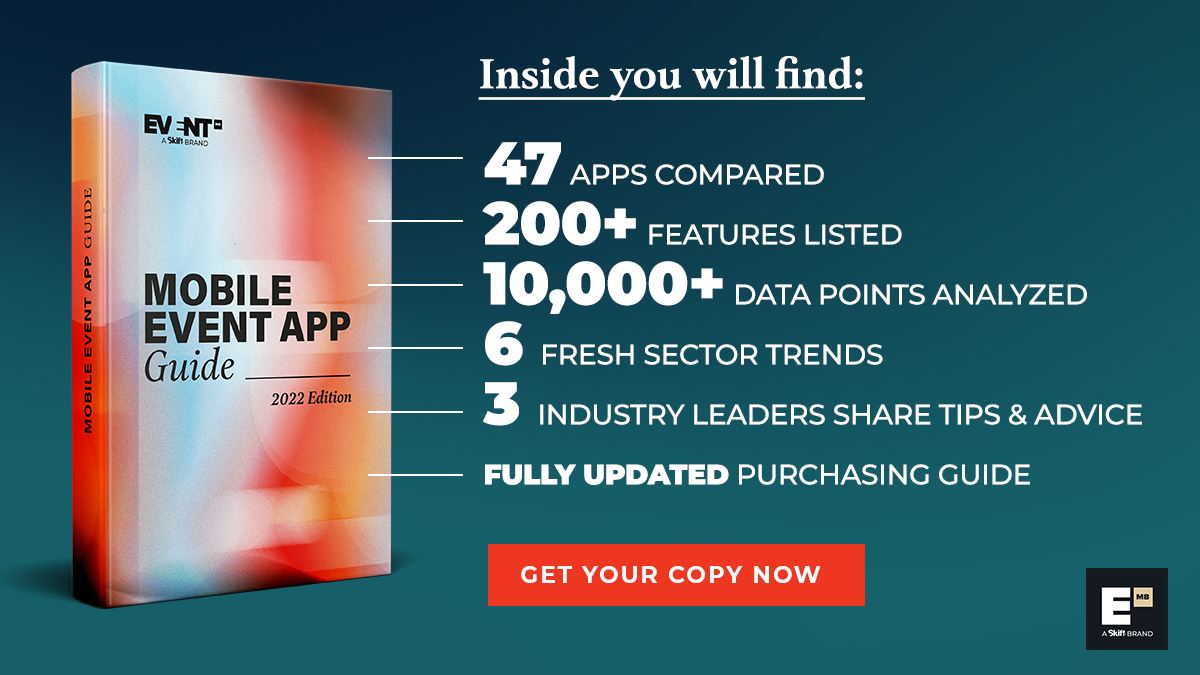This article is based on content included in the 2022 edition of the EventMB Mobile Event App Guide. The complete guide is a highly recommended resource for all event professionals interested in mobile event apps. Download your copy for free today!
Over the course of the Covid pandemic, the relevance of mobile event apps has waned. Instead, the focus shifted almost entirely to virtual event platforms, used primarily on desktop devices.
Two years later, with in-person events once again taking place, mobile event apps are the go-to tools to bring hybrid events to life. They uniquely provide attendees with complete freedom in how they choose to participate in an event. A well-implemented mobile event app can and should be the core participation vehicle for participants on the move, be they onsite or not.
In researching the mobile event app marketplace to produce the EventMB Mobile Event App Guide, we surveyed 65 mobile event app providers. The trends below are based on this data.
Hybrid Is Here to Stay
The outlook for in-person gatherings looks promising, but the event industry will not be returning to the pre-2020 version of “business as usual,” wherein digital was often treated as an afterthought. Instead, nearly 60 percent of providers anticipate hybrid will be the go-to event format this year, with just 18 percent expecting in-person-only events to dominate.
In terms of costs, there is an almost equal split between providers that offer separate pricing (52 percent) for virtual-only events, in-person-only events, and hybrid events and those that do not (48 percent).
As event organizers sift through a maze of vendors to pull off the digital component of their events, more of these providers want to deliver all the services — not just the app. Seventeen percent of event tech providers only offer their app in conjunction with their virtual event platform. In other words, their mobile event app is not available as a standalone service.
More Flexible Contracts and Payment Terms
Every event organizer has one big question on their minds regarding technology: How much does it cost?
While the pricing structure of apps varies based on various factors, the industry is becoming more friendly about the ability to back out of that full sticker price. Eighty-two percent of providers have developed a more flexible contract policy due to the increased risk of cancellation or postponement as Covid numbers ebb and flow and local restrictions evolve.
And for event organizers at companies juggling the cash flow challenges of an uncertain economy, the bill for app services can’t always be settled in one lump sum. Seventy-five percent of companies have flexible payment terms and financing options.
Video Live Streaming as Standard
While the value proposition of an event app has historically relied on its ability to elevate the in-person experience, new features are designed to assist remote participants. Eighty-two percent of providers offer live video streaming within the app, giving virtual participants the convenience of an on-the-go event experience. Additionally, anecdotal reports suggest that a growing number of in-person attendees want to consume some of the event content outside the venue, for example, from the comfort of their hotel rooms.
There is also a heightened focus on helping create a connection between sponsors and the participants who won’t see any in-person signage. Seventy-seven percent of providers make it possible for companies to sponsor video rooms and group video calls with attendees.
The Rise of Subscriptions
App providers are increasingly recognizing the value of creating a tool that delivers 365 days of meaningful value versus one that serves as a last-minute download for a few days of education and networking. The industry is moving towards year-round services: 88 percent of app providers offer an on-demand video library feature. As organizers work to keep attendees engaged after the closing session, mobile apps can be a convenient vehicle for consuming the content they may have missed during the live experience.
The subscriber model will inevitably face pushback from some organizers who want to only pay for active months. However, this can be an opportunity to remind the industry that every month should be full of content and connections that remind an audience of why they attended the event — and why they should be there again the following year.
Stiff Competition Spells Good News
There’s no monopoly ruling over the mobile app landscape. On the contrary, nearly 60 percent of companies indicate that competition is higher than last year. That’s good news for event organizers. Increased competitive pressure creates a win for customers — whether with lower-priced options or higher-priced tiers with the extraordinary features that make them well worth the investment.
As app providers work behind the scenes to unveil new tools that capture attention, they’re also working to keep pace with RFPs and existing client needs: 60 percent say that demand for their services is up compared with last year.
Getting Ready for the 5G Revolution
While questions about the fifth-generation wireless network weren’t part of this year’s survey, it’s safe to say that 5G is on the mind of every event technologist. As 5G rolls out worldwide, there will be an ability to do more — and to do it faster — in a mobile app. Attendees will enjoy a smoother video streaming experience, but the big opportunity lies in the potential to bring the full scale of immersive possibilities into an app.
Will 2022 finally be the year when AR and VR transform from buzz-worthy acronyms into real game-changers for the attendee experience? We’re excited to find out.







